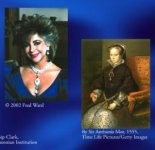V
Valeria101
Guest
Well, the new necklace might have been loosely inspired by the old.
But was Anthonis Mor so blind to the color and shape of Mary Tudor's jewel? One could make a copy of the setting with as much detail as given in the painting, but hardly recognize the size and color of the enormous pearl in Liz Taylor's necklace.
Could these possibly be one and the same? What do you make of it?
Links to source for portrait.
Link to source for necklace picture. (Thanks Caitlin!)
The relevant detail:

Click on the thumbnail image below for the screen-full... (oops for the adds!)

But was Anthonis Mor so blind to the color and shape of Mary Tudor's jewel? One could make a copy of the setting with as much detail as given in the painting, but hardly recognize the size and color of the enormous pearl in Liz Taylor's necklace.
Could these possibly be one and the same? What do you make of it?
Links to source for portrait.
Link to source for necklace picture. (Thanks Caitlin!)
The relevant detail:

Click on the thumbnail image below for the screen-full... (oops for the adds!)

Last edited by a moderator:









